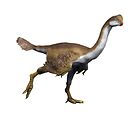Ypupiara
| Ypupiara Temporal range: Late Cretaceous,
| |
|---|---|

| |
| Restoration of head | |
| Scientific classification | |
| Kingdom: | Animalia |
| Phylum: | Chordata |
| Clade: | Dinosauria |
| Clade: | Saurischia |
| Clade: | Theropoda |
| Family: | †Dromaeosauridae |
| Subfamily: | †Unenlagiinae |
| Genus: | †Ypupiara Brum et al., 2021 |
| Species: | †Y. lopai
|
| Binomial name | |
| †Ypupiara lopai Brum et al., 2021
| |
Ypupiara (meaning "the one who lives in the water") is an extinct genus of unenlagiine theropod from the Late Cretaceous Marília Formation of Brazil.[1] It was the first member of the Dromaeosauridae to be discovered in South America and the first member of the Unenlagiinae to be discovered, but not the first to be identified as such. The type and only species, Y. lopai, is known solely from a specimen that was destroyed in a fire in 2018.
Discovery and naming[]
The holotype, DGM 921-R, a right maxilla and dentary (which was associated with a fish jaw), was discovered in a layer of the Late Cretaceous Marília Formation of Brazil. It was found by sometime between 1940 and 1960, after which Llewellyn Ivor Price listed the fossil as belonging to an indeterminate vertebrate.[1] The specimen was then placed in storage at the National Museum of Brazil and was not acknowledged again for another 80 years.
Photographs of the holotype were taken shortly before it was destroyed when the museum it was housed in was heavily damaged in a fire on 2 September 2018.[1][2][3][4] The paper naming and describing the holotype was due to be submitted around the same time as the fire that destroyed the fossil, but was delayed because of the fire. The generic name, Ypupiara, is derived from a Tupi word meaning "the one who lives in the water," in reference to a local mythological creature and its inferred diet of fish. The specific name, lopai, honors the holotype's discoverer.[1]
Around the time that the Ypupiara holotype was discovered, a single metatarsus belonging to a dromaeosaurid was found. This specimen, known as "Lopasaurus" (meaning "Alberto Lopa's lizard"), was lost sometime after the death of Llewellyn Ivor Price in 1980. It was acknowledged by Brum et al. (2021), where they tentatively referred "Lopasaurus" to the Unenlagiinae, but they could not determine whether "Lopasaurus" represents the same taxon as Ypupiara, due to the lack of overlapping material.[1]
Description[]
Based on the size of the preserved fossil material, Ypupiara is estimated to have been around 2–3 metres (6.6–9.8 ft) long when fully grown. It is hypothesized that Ypupiara preyed on smaller animals including mammals, reptiles and fish.[1]
Classification[]
For the 80 years before it was described, Ypupiara was classified as an indeterminate vertebrate. It was not until it was described in 2021 by Brum et al. when it was recognised as a theropod belonging to the Unenlagiinae. Ypupiara was found to be the sister taxon to Austroraptor.[1]
References[]
- ^ a b c d e f g Brum, Arthur Souza, Pêgas, Rodrigo Vargas, Bandeira, Kamila Luisa Nogueira, Souza, Lucy Gomes de, Campos, Diogenes de Almeida, & Kellner, Alexander Wilhelm Armin. (2021). A new Unenlagiinae (Theropoda: Dromaeosauridae) from the Late Cretaceous of Brazil. https://doi.org/10.1002/spp2.1375
- ^ "Rio's 200-year-old National Museum hit by massive fire". Reuters. 2 September 2018. Archived from the original on 3 September 2018. Retrieved 2 September 2018.
- ^ "Incêndio atinge prédio do Museu Nacional, no Rio". UOL Notícias (in Portuguese). 2 September 2018. Archived from the original on 3 September 2018. Retrieved 2 September 2018.
- ^ "Lessons from the destruction of the National Museum of Brazil". The Economist. Retrieved 10 September 2018.
- Unenlagiines
- Maastrichtian life
- Late Cretaceous dinosaurs of South America
- Cretaceous Brazil
- Fossils of Brazil
- Marília Formation
- Taxa named by Alexander Kellner
- Fossil taxa described in 2021















